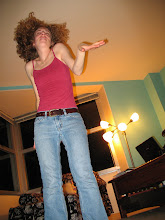Like true New Yorkers, Patty, Katie, and I escaped to the Berkshires this weekend. We had the most glorious time driving on the Taconic, eating good food, and seeing the sites. We really didn’t want to come back—at least not for a couple more days.
Patty and Katie stretching their legs after 3.5 hours in the car.
The
The impetus for our trip was Toulouse-Lautrec and Paris at the
MASS MoCA
On Saturday evening, we headed over to MASS MoCA for “13 Most Beautiful… Songs for Andy Warhol’s Screen Tests,” a film with live music written and performed by Dean and Britta. From 1964 to 1966, Warhol filmed Screen Tests, silent film portraits of Factory regulars. In all, there were over 500 of these screen tests. With a commission from the
The concept struck me as a little hipster chic and precious (but then again, Andy Warhol, himself, often verged dangerously close to the precious). Surprisingly, parts of the evening turned out to be quite moving. And not because in between sets, Dean would say things like “and he danced out a window and fell four stories to his death, and she went for cigarettes in 1986 and never came back, and in the 70s he was standing on the side of the road and was struck by a car.” No, the evening was moving because while Warhol often simply filmed insolent girls and jaded men who flipped off the camera, sometimes he managed to capture the essence of being human, in all of its beauty and quirkiness, vividness and vulnerability. Still, the most thrilling part of the evening was discovering that Britta was the voice of JEM in Jem and the Holograms (you know the original Hannah Montana).
Smith College Museum of Art
On Sunday morning, we drove to Smith so Katie could ogle a painting for work. The Met is borrowing it for an exhibition and she and the curator needed to know what color the sky was actually painted. Somehow, they suspected that Lily Martin Spencer wouldn’t really paint a sky yellow. It turns out the photo they received was way off, the painting was a washed out blue.
While we were there, we wandered into Thin and Girl Culture. It was perhaps one of the most upsetting, chilling, thought-provoking, and socially driven exhibitions I’ve ever seen. Photographer Lauren Greenfield combined two of her prior projects, a documentary series of photographs of women at Renfrew, an eating disorder treatment facility with another documentary series which explored the image-obsession of girls in America.
This is exactly the sort of exhibition college art museums should be doing, particularly a leading women’s college like Smith. The exhibition pushes the enveloped and it forced people to think hard about the social construction of beauty and womanhood, the danger of a homogenous conception of beauty, and the overwhelming, sociological urge to fit in and be loved.
The Eric Carle Museum of Picture Book Art
We ended our trip on a way lighter note. And, if you ask me (although Patty and Katie might disagree), we saved the best for last. We went to the Eric Carle Museum. I have been busting to get to this place for years, but every time I was thwarted by a perfect storm of circumstances. But, at long last, I made it there! It was even more magical than I expected. There was a wonderful exhibition about the making of The Very Hungry Caterpillar. Eric Carle originally named him Willy Worm! Thankfully, his editor intervened. There were mock-ups of the pages and a case which showed how Carle gouached pieces of white paper and then cut shapes from them to make his collages. There was also a fantastic exhibition about Virginia Lee Burton, the beloved illustrator of The Little House.
I cannot rave enough about the museum. I loved the physical building; it is so light and airy, yet made wonderfully inviting by huge, colorful, abstract paintings by Carle and children’s crafts hanging in the windows. I was enchanted by the adorable, child-sized library with hundred of picture books and the huge craft room. But what I really loved about the museum is that it found the perfect balance between appealing to kids and adults. There was plenty for kids to look at and great activity guides for them and adults had substantial, interesting labels to read.
I can’t wait to get back up there. There are so many places we just didn't have time to visit!










